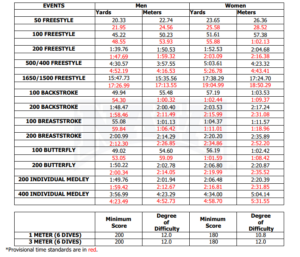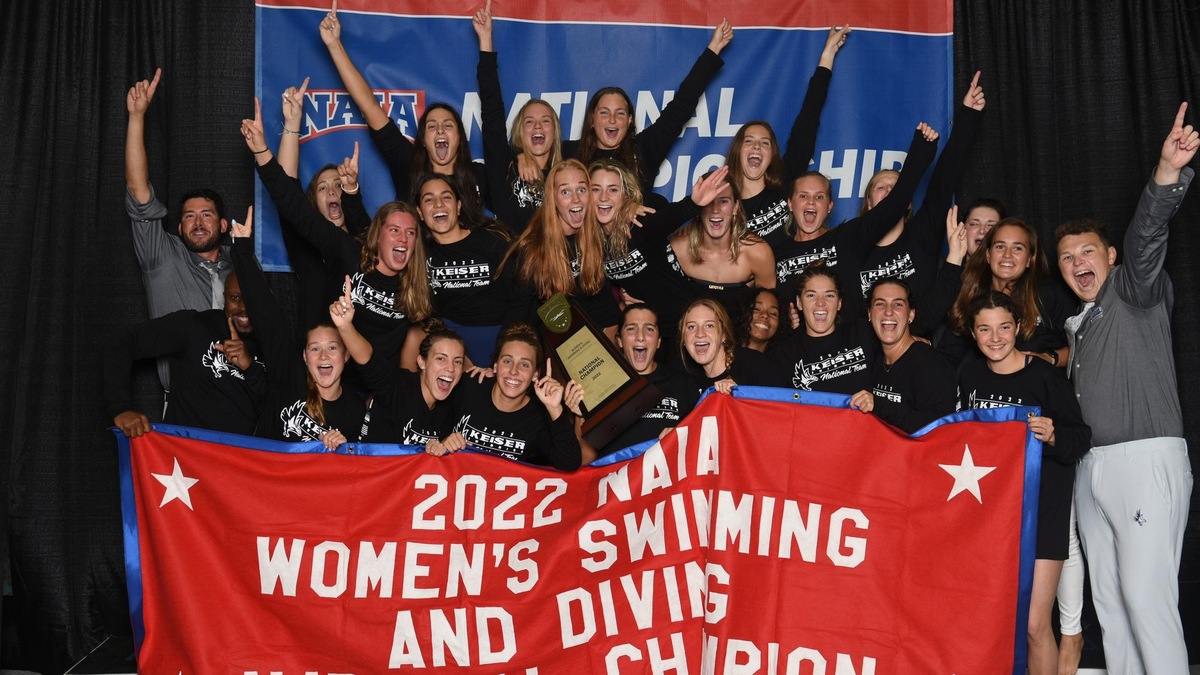The National Association of Intercollegiate Athletics (NAIA) has released the cuts for the 2023 NAIA Swimming and Diving Championships, which will take place from March 1 – 4, 2023 at the Columbus Aquatics Center in Columbus, GA.
Looking at the 2023 standards, there is only one consideration time standard that got faster from 2022 to 2023: the men’s 200 backstroke. In 2022, the consideration time stood at 2:01.81, while this year swimmers will have to hit a 1:58.46 in the event. All of the other consideration time standards remained the same, while no record of last year’s automatic qualifying standards could be found.
2023 NAIA Championship Cuts

After facing backlash because the selection procedures for the 2022 Championships left swimmers ranking in the top 10 in the NAIA out of the competition, the NAIA altered its selection procedures for this year’s meet. According to the official document sent to coaches, the meet will once-again be capped at 300 swimmers (140 Men & 160 Women) and maximum of 16 Divers (8 Men & 8 Women).
For selection, all swimmers who have hit the automatic qualifying times will first be added to the meet. Those swimmers will be allowed to contest up to 2 additional events, provided they’ve hit the provisional time standard in them. Then, the next fastest swimmers in each event are added until every event has the same number of entries. This will be done until either the cap is hit or until there are not enough remaining spots across the events to fill another row of additions. In that case, the swimmers closest NAIA automatic cut will get added first in the final row until the spots are filled.
Here’s where the selection procedures differ greatly from last season. In 2022, relay swimmers for all qualified relays were added to the meet before any swimmers with the provisional cuts were accounted for, resulting in far fewer swimmers with provisional cuts being selected. This year, the meet will feature no relay only swimmers, and instead, any team with 4 swimmers already qualified individually for the meet can enter up to 5 relay events. Thus, only those swimmers qualified to swim individually will be allowed to compete on relays.
All teams will be capped at a total of 18 athletes per gender, including alternates, with divers counting as ½ an entry.

Yuck.
It will be very interesting to see how many teams qualify for relays this year. Obviously the power house teams will be represented, but new and small teams are going to struggle. In my opinion the cap is too restrictive. There should be a set number of swimmers per event and slots are filled according to the best time list. Then swimmers with too many events scratch unwanted events and those slots are filled with the next in line. Relays should have time standards and only teams that achieve those standards should be competing. How long does it really take to run a couple heats of relays per session anyway?
Time…money…”championship”.
You have to draw the line somewhere.
I could see them expanding like the NCAA did, and not counting relay-only swimmers. But in individual events? Example: women’s 500 free in 2019, took 5:15 to score. In 2019, the “A” standard was 5:26. I just don’t know that it provides a ton of value to the championship to expand that further. If anything, it devalues conference championship meets – which to me, the NAIA should be celebrating more than the NCAA does.
I was just suggesting filling heats that are already going to run and setting a standard number of heats depending on the specific event. Spectators might enjoy seeing the top 40, 50 yard freestylers (5 heats) but only need a max of 3 heats (24 competitors)of the mile.
Gotcha. I think that’s easier said than done sometimes. Plus if you give certain events an advantage over others…you’ll start seeing a whole different set of complaints roll through.
Understood. People are going to find reasons to complain because they feel that their event is being short changed. But obviously an extra heat of50 or 100 free is much faster and looking at the men’s prelim participants from last year there were 42/50 free, 48/100 free, while only 16/400 IM and 19/1650 free. People need to recognize the difference in participation levels. The glamor events have not and will not change.
When the Executive committee for the NAIA Coaches ran the numbers from this year, every event would had at least 24 competitors with one exception, the mens 1650 free which had 23
That would be great and thanks for the info. Ultimately the swimmers need to produce as there aren’t going to be participation prizes (free entries) anymore. Our team is new but expanding rapidly. May just take a little while longer to get that first national qualifier.
So how many heats or swimmers will be allowed in each event this year?
The next stage will be to reinstate the relay qualifying standards and a “relay only” pool of swimmers, similar to the NCAA
the NAIA operates all their national championships in every sport on what they call the Access Ratio. The number of athletes at nationals relative to the number of athletes in the NAIA.
in 2020, every sport was at the NAIA threshold of 22% or below the Access ratio. Swimming was at 69% for the men and 72% for the women. That’s what prompted the change and the drastic over correction.
the NAIA National office and the National Advisory Council which oversees championships, is on board with expanding the field some to include the relay expansion. … Read more »
Good info, thanks for sharing. And you make a good point – NAIA is growing at a rate that’s hand-and-fist ahead of the rest of college swimming, so there’s going to be an adaption period. The NAIA of today is almost unrecognizable from the NAIA 10 years ago, and I think in another 10 years, it will be unrecognizable again.
Having 12 years in with the NAIA, I can truly say it’s not what it once was. My first nationals in 2012 has 21 schools. Even with all the defections, we will have over 40 this year in the NAIA with 3 new programs on the horizon for fall 2023
1. Three years is too long. That is almost a college career for a swimmer.
2. To make such drastic changes this year is very discouraging to swimmers. 3. More deference should be given to Conference Chamionships. Anyone taking 1st or 2nd should be given a slot at NAIA Nationals as long as they meet the B cut. First place Relay Teams at Conference should also be given consideration.
4. Prediction: This years’ changes will be destructive to smaller/newer schools.
This is the humble opinion of a grandfather of two present & one graduated NAIA swimmers.
Part of the challenge is not all teams are in exclusively NAIA conferences. Also some conferences are packed. Keiser and St Thomas in the same conference really squeezes the others in that conference. I agree this will be harder for smaller/new schools.
Last years relay selection focused policy probably allowed some less strong teams the opportunity to get to nationals with their relays. This time around probably gives greater opportunities for individuals especially in longer events or stroke events. However, there may be less teams that actually get there. Also more pressure on the sprinters. Bottom line is teams know the criteria and so plan accordingly. Time will tell how much of an actual difference it makes.
Shame on the NAIA.
For?
This is how swimming works. The fastest times in each event get to swim. Kids train hard and earn their spots. Last year’s process left many of the top 8 swimmers uninvited. Thank you NAIA for listening our concerns.
It wasn’t that many (like 2?) but ok